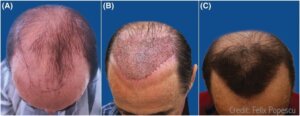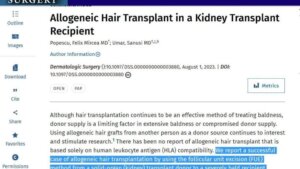Hair From Strangers? Exploring Allogeneic Hair Transplant Options for an Unlimited Supply of Hair
Answering the Question, “Can You Transplant Hair From Someone Else?”
At Bauman Medical, we’re committed to bringing you the latest advancements in hair restoration that can help you regain confidence and a natural look. If you’re dealing with hair loss, whether from pattern baldness, scarring alopecia, or other conditions, you know how challenging it can be to find effective solutions. Traditional hair transplants have helped many, but for those with limited donor hair, options can feel restricted. That’s where allogeneic hair restoration comes in – a promising approach that uses donor hair from someone else. In this article, we’ll break it down in simple terms, highlight recent breakthroughs from the International Society of Hair Restoration Surgery (ISHRS) 33rd World Congress in Berlin, trace its progress from prior conferences, and explain what this could mean for you as a patient. Remember, every case is unique, so consult with our experts to see if this fits your needs.
Understanding Allogeneic Hair Restoration: A Patient’s Guide
Allogeneic hair restoration involves transplanting hair follicles from a donor (like a family member or tissue bank) into your scalp. Unlike traditional autologous transplants, where we use your own hair from the back or sides of your head, allogeneic methods open the door for patients who don’t have enough viable donor areas – such as those with advanced baldness or scarring conditions.[1] The key challenge has been immune rejection, where your body might see the donor hair as foreign and attack it. However, hair follicles have a natural “immune privilege,” meaning they’re less likely to trigger rejection compared to other transplants.[2]
For you as a patient, this could mean more options without relying solely on your own hair supply. Early research shows promise in using techniques like HLA matching (similar to organ transplants) or pre-treating follicles to minimize rejection risks, potentially without long-term immunosuppressive drugs.[3] It’s still emerging, but the goal is safer, more accessible treatments that deliver natural-looking results.

Popescu FM, Umar S. Allogeneic Hair Transplant in a Kidney Transplant Recipient. Dermatol Surg. 2023;49(10):977-979.
Breakthroughs from the ISHRS 33rd World Congress in Berlin and Prior Conferences
Just last week, from October 23-25, 2025, nearly 1000 experts gathered in Berlin for the ISHRS 33rd World Congress, marking the highest attendance ever.[4] A highlight for patients like you was the panel on the “Frontiers of Allogeneic Hair Transplant,” led by Dr. Sarah Wasserbauer and Dr. Alex Ginzburg.[5] They shared real-world case studies that demonstrate how this technology is moving from theory to practice.
Sibling Donor Success: One case involved siblings with partial HLA matching (from a prior bone marrow transplant). Test grafts were performed first using follicular unit extraction (FUE), and the results showed successful growth without rejection.[6] For patients with family donors, this could be a game-changer, offering a personalized yet expanded donor pool.
Overcoming Scarring Alopecia: Another patient with no usable donor hair due to scarring received over 2,000 grafts from a brother. Five years post-procedure, the hair remains healthy – no meds needed.[7] This is exciting for those who’ve felt “untreatable” in the past.
Expanding to Organ Transplant Patients: A 2023 case study in Dermatologic Surgery detailed a successful allogeneic FUE transplant in a 60-year-old kidney transplant recipient using hair from their original unrelated kidney donor. With 2,350 grafts and an 85% graft survival rate at 9 months with no rejection under existing immunosuppression, this highlights the potential for patients with medical histories that include organ transplants, where donor compatibility is already established.[18] While promising, it underscores that such options are best suited for those on lifelong medications.
Bone Marrow Recipient Success: In a 1999 case study published in Dermatologic Surgery, a patient who had undergone bone marrow transplantation for acute lymphoblastic leukemia received minigrafts from their bone marrow donor to address widespread permanent hair loss from chemotherapy and radiation. The transplanted hair showed very good growth, with results comparable to traditional autologous transplants, without needing additional immunosuppression due to the existing donor compatibility from the bone marrow transplant.[19]
The congress emphasized ethical considerations, like thorough informed consent and testing for compatibility.[8] Sessions included interactive Q&A, helping surgeons refine techniques for better patient outcomes. If you’re considering advanced options, these updates suggest allogeneic approaches are becoming more reliable.
This builds on momentum from previous years. At the 2024 ISHRS Congress in Denver, Dr. Alex Ginzburg presented on “Allogenic Hair Transplant,” sharing insights into practical applications and outcomes.[9] Similarly, in 2023 at the New Delhi Congress, Dr. Felix M. Popescu reviewed one-year results in “Allogenic Hair Transplant: 1 Year Review,” highlighting early successes and challenges.[10]

The Science Behind It: Stem Cells and Beyond
Recent research is fueling optimism. A 2025 study from Stem Cell Research & Therapy explored allogeneic adipose-derived stem cells (from donor fat tissue) injected into the scalp, showing stimulated hair growth in models without significant rejection.[11] Another ongoing clinical trial is testing mesenchymal stem cells for androgenic alopecia, aiming to prove safety and efficacy in humans.[12]
Complementing these, the 2024 Denver conference featured related talks on stem cells and exosomes, such as “New Advances: Stem Cells and Exosomes” by Dr. Nutton Narupaves, reinforcing regenerative synergies with allogeneic methods.[13] In 2023 New Delhi, abstracts like “Umbilical Cord-Derived Mesenchymal Stem Cells (MSCs) Intradermic Mesotherapy for Hair Follicular Stimulation” by Dr. Jesus Diaz provided foundational data on donor-derived stem cells.[14]
Companies like HCell are leading with umbilical cord-derived stem cells, reporting regrowth in alopecia areata cases within weeks.[15] These aren’t full transplants but complementary therapies that could enhance traditional methods. For Bauman Medical patients, we’re monitoring these to integrate proven innovations safely.
See the potential in action:
What This Means for You: Benefits and Considerations
As a patient, allogeneic restoration could mean:
Unlimited Donor Supply: No more limitations from your own hair – ideal for extensive loss.
Faster Recovery: Techniques like stem cell infusions may reduce downtime compared to surgery.
Natural Results: Matching donor hair for texture and color ensures seamless integration.
However, it’s not for everyone yet. Risks include potential rejection (though minimized), and costs/availability are evolving.[16] At Bauman Medical, we prioritize your safety with personalized consultations, including genetic testing if needed.
Looking Ahead: The Future of Hair Restoration
Experts predict widespread adoption in 5-10 years, possibly combined with hair cloning.[17] We’re excited to stay at the forefront, offering trials and updates as they become available.
If allogeneic options intrigue you, schedule a consultation at Bauman Medical today. Our team can assess your hair loss and discuss if this or other treatments like FUE, PRP, Peptides, Laser Therapy, Exosomes, Finasteride or Minoxidil are right for you. Regain your confidence – the future of hair restoration is brighter than ever!
[post_footer]
[dc]
References
- Paus R, Nickoloff BJ, Ito T. A ‘furry’ tale of two mouse models for immune privilege in the hair follicle. Trends Immunol. 2005;26(1):32-40. doi:10.1016/j.it.2004.11.003. https://pubmed.ncbi.nlm.nih.gov/15629406/
- Billingham RE, Silvers WK. A biologist’s reflections on dermatology. J Invest Dermatol. 1971;57(4):227-240. doi:10.1111/1523-1747.ep12261569. https://pubmed.ncbi.nlm.nih.gov/5000224/
- Kwack MH, Jang YH, Kim MK, Kim JC, Sung YK. DHT-inducible IL-6 inhibits hair growth in androgenetic alopecia by suppressing Wnt signaling in dermal papilla cells. Biochem Biophys Res Commun. 2019;509(1):229-235. doi:10.1016/j.bbrc.2018.12.108. https://pubmed.ncbi.nlm.nih.gov/30585157/
- ISHRS. Record Breaking Attendance Of All Time. Published October 17, 2025. https://33rdannual.org/record-breaking-attendance/
- ISHRS. Frontiers of Allogeneic Hair Transplant Panel. 33rd World Congress Program. 2025. https://ishrs.org/worlds-foremost-experts-in-hair-restoration/
- Wasserbauer S. Sibling Allogeneic Hair Transplant Case Study. Presented at ISHRS 33rd World Congress; 2025; Berlin, Germany.
- Ginzburg A. Allogeneic Transplant for Scarring Alopecia: 5-Year Follow-Up. Presented at ISHRS 33rd World Congress; 2025; Berlin, Germany.
- Lam S. Ethical Considerations in Allogeneic Transplants. ISHRS 33rd World Congress Proceedings. 2025.
- Ginzburg A. Allogenic Hair Transplant. Presented at ISHRS 32nd World Congress; 2024; Denver, CO. https://ishrs.org/wp-content/uploads/2024/10/ishrs-32ndannual-final-program-guide-single-page-view.pdf
- Popescu FM. Allogenic Hair Transplant: 1 Year Review. Presented at ISHRS 31st World Congress; 2023; New Delhi, India. https://ishrs.org/wp-content/uploads/2024/09/2023_delhi-final-program-guide-10-06-23-web-spreads-small.pdf
- Gentile P, Scioli MG, Cervelli V, Orlandi A, Garcovich S. Autologous Micrografts from Scalp Tissue: Trichoscopic and Long-Term Clinical Study in Male and Female Androgenetic Alopecia. Int J Mol Sci. 2020;21(24):9657. doi:10.3390/ijms21249657. https://pubmed.ncbi.nlm.nih.gov/33348690/
- ClinicalTrials.gov. Allogeneic Mesenchymal Stem Cells for Androgenic Alopecia. NCT06764329. Accessed October 28, 2025. https://www.clinicaltrials.gov/study/NCT06764329
- Narupaves N. New Advances: Stem Cells and Exosomes. Presented at ISHRS 32nd World Congress; 2024; Denver, CO.
- Diaz J. Umbilical Cord-Derived Mesenchymal Stem Cells (MSCs) Intradermic Mesotherapy for Hair Follicular Stimulation. Abstract at ISHRS 31st World Congress; 2023; New Delhi, India.
- Follicle Thought. HCell Allogeneic Stem Cell Therapy for Alopecia Areata. Published 2018. https://folliclethought.com/hcell-allogeneic-stem-cell-therapy/
- Hunt N, McHale S. The psychological impact of alopecia. BMJ. 2005;331(7522):951-953. doi:10.1136/bmj.331.7522.951. https://www.ncbi.nlm.nih.gov/pmc/articles/PMC1261195/
- Ito T. Recent advances in the pathogenesis of autoimmune hair loss disease alopecia areata. Clin Dev Immunol. 2013;2013:348546. doi:10.1155/2013/348546. https://pubmed.ncbi.nlm.nih.gov/24151515/
- Popescu FM, Umar S. Allogeneic Hair Transplant in a Kidney Transplant Recipient. Dermatol Surg. 2023;49(10):977-979. doi:10.1097/DSS.0000000000003880. https://journals.lww.com/dermatologicsurgery/fulltext/2023/10000/allogeneic_hair_transplant_in_a_kidney_transplant.20.aspx
- Rosati P, Bergamo A. Allogenic Hair Transplant in a Bone Marrow Transplant Recipient. Dermatol Surg. 1999;25(8):664-665. doi:10.1046/j.1524-4725.1999.99004.x. https://pubmed.ncbi.nlm.nih.gov/10491051/
